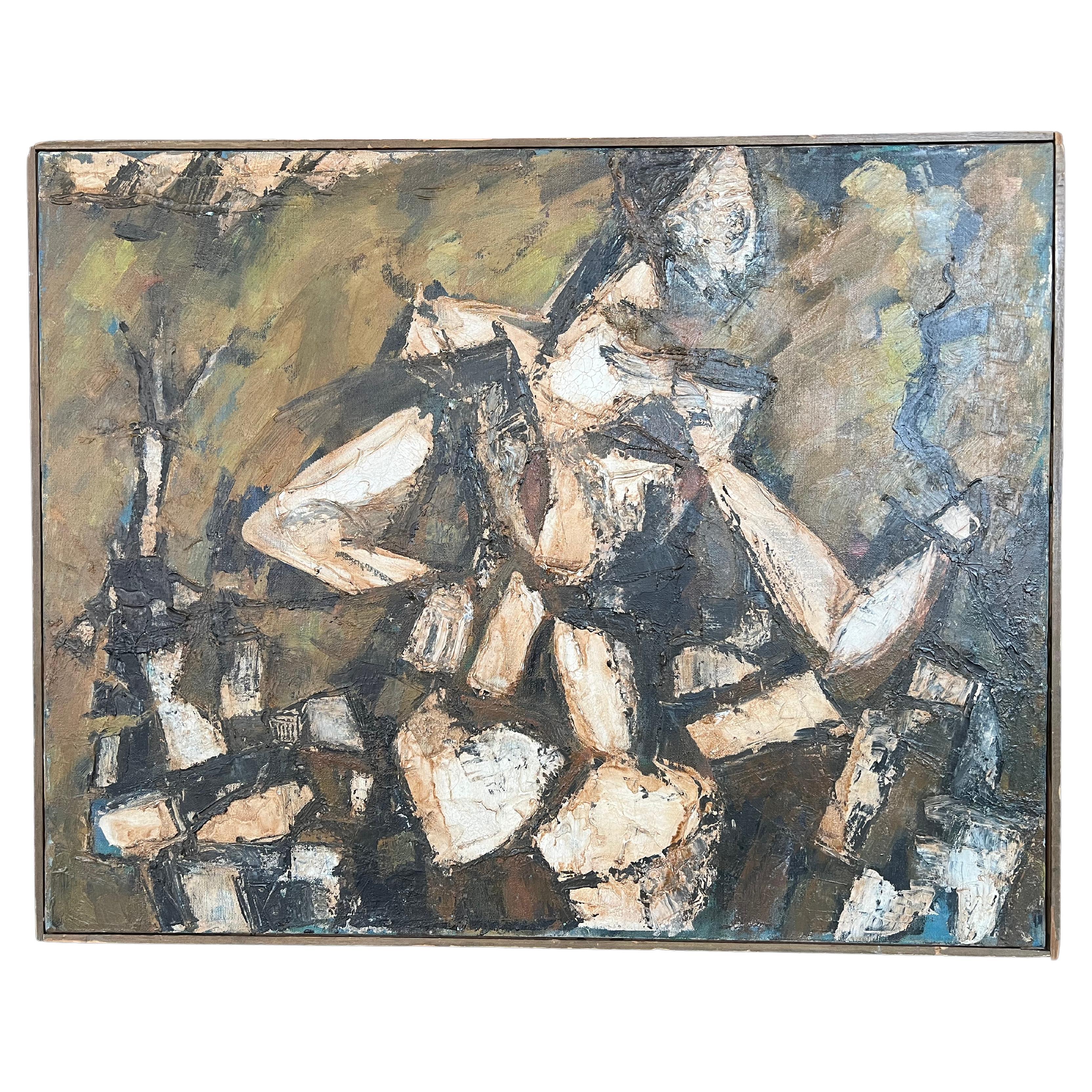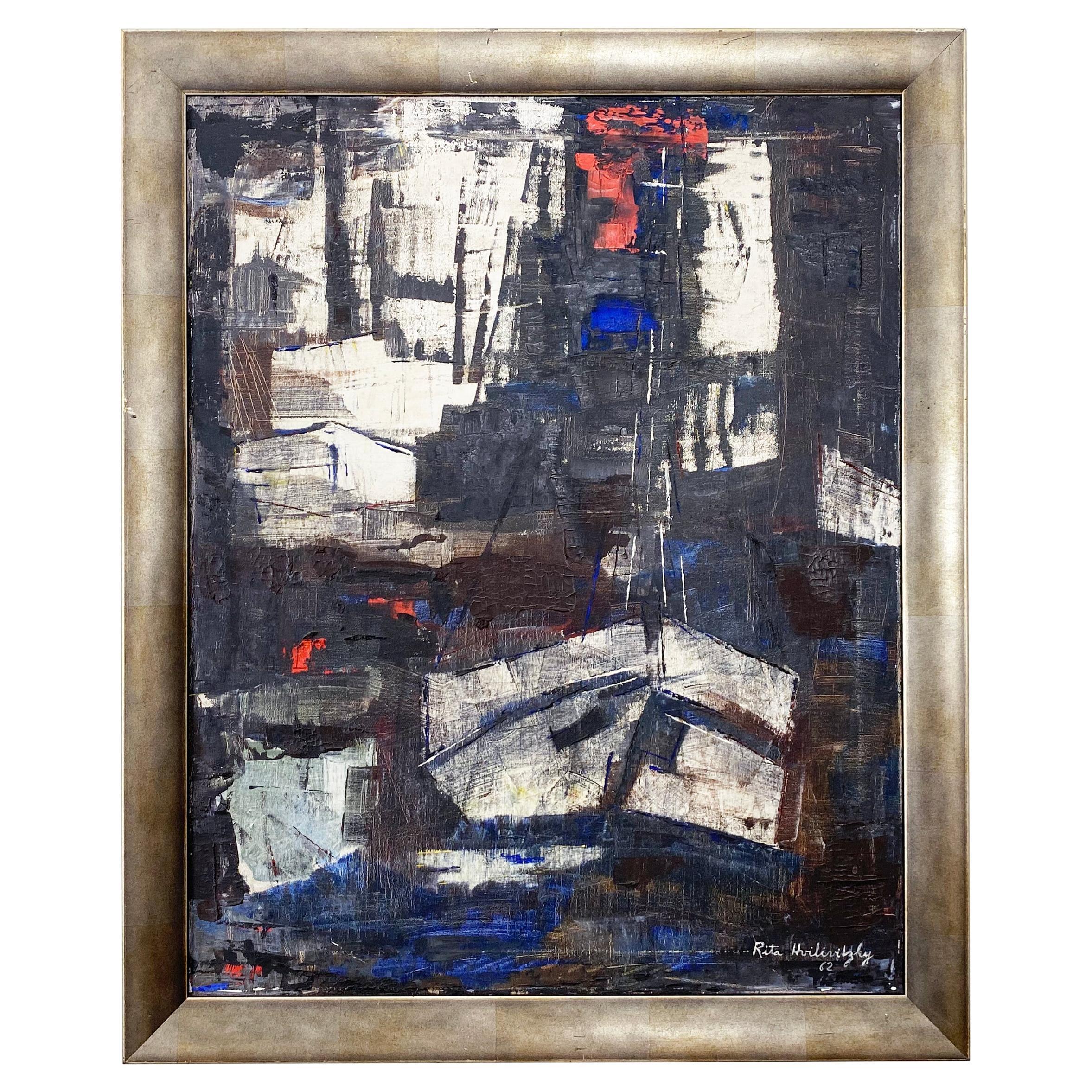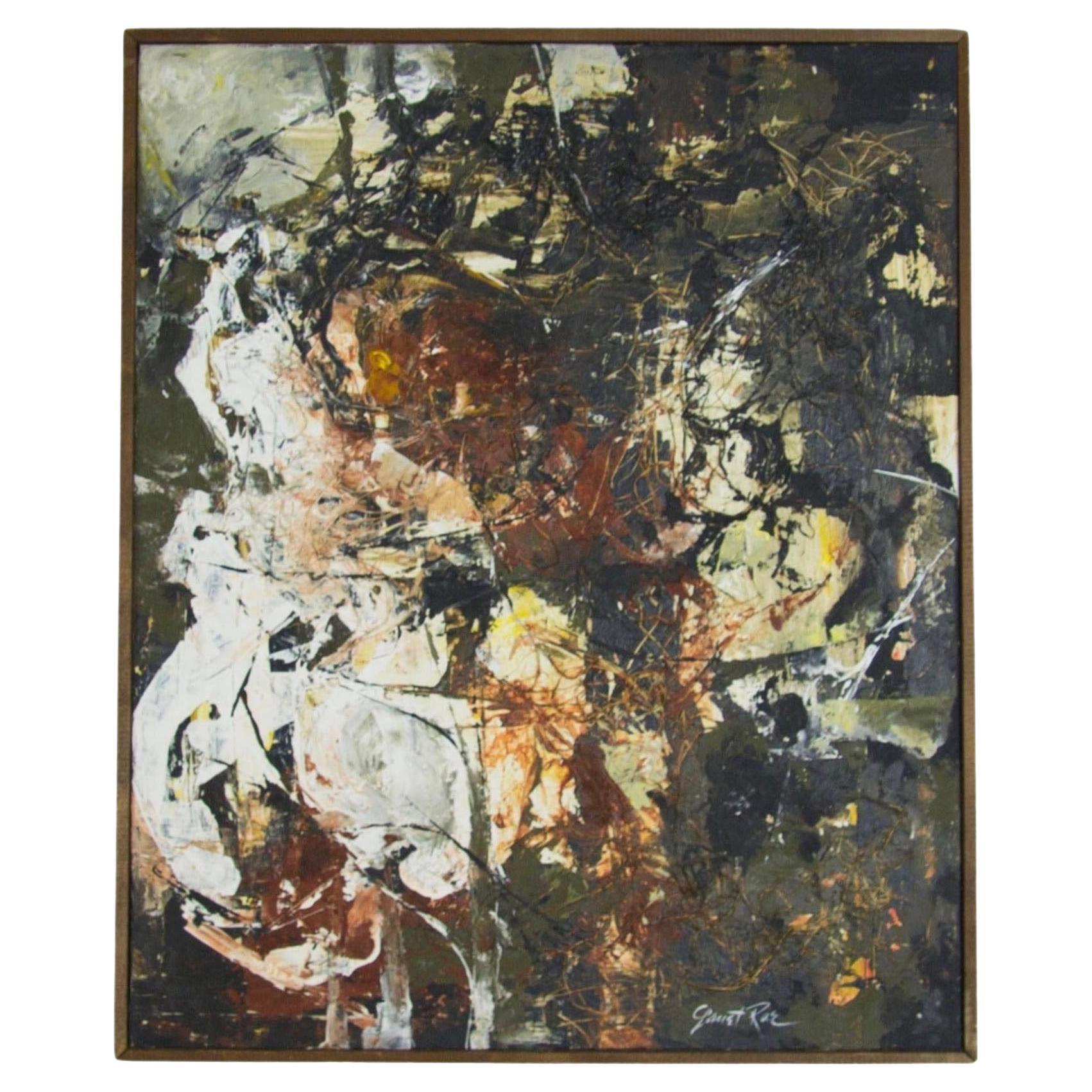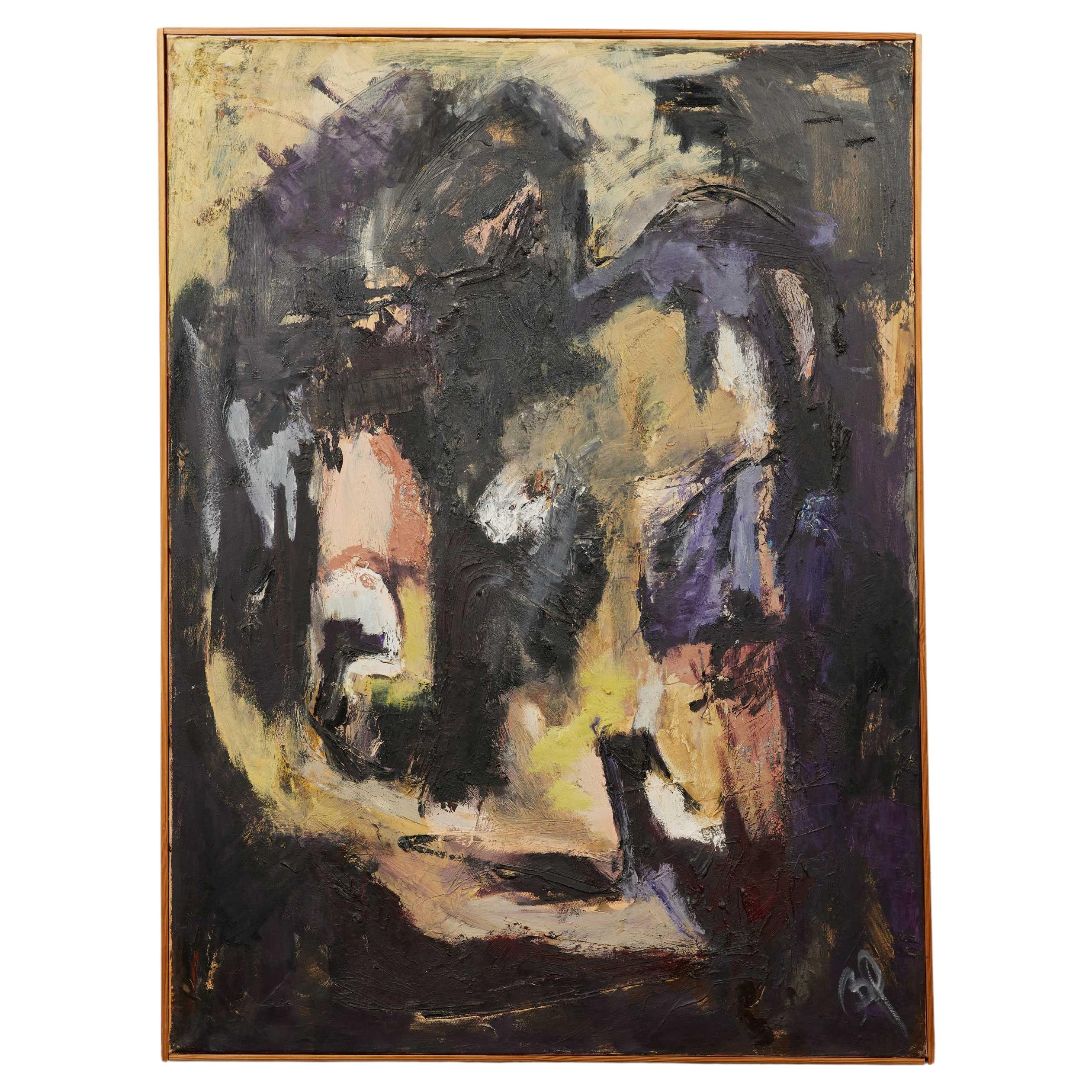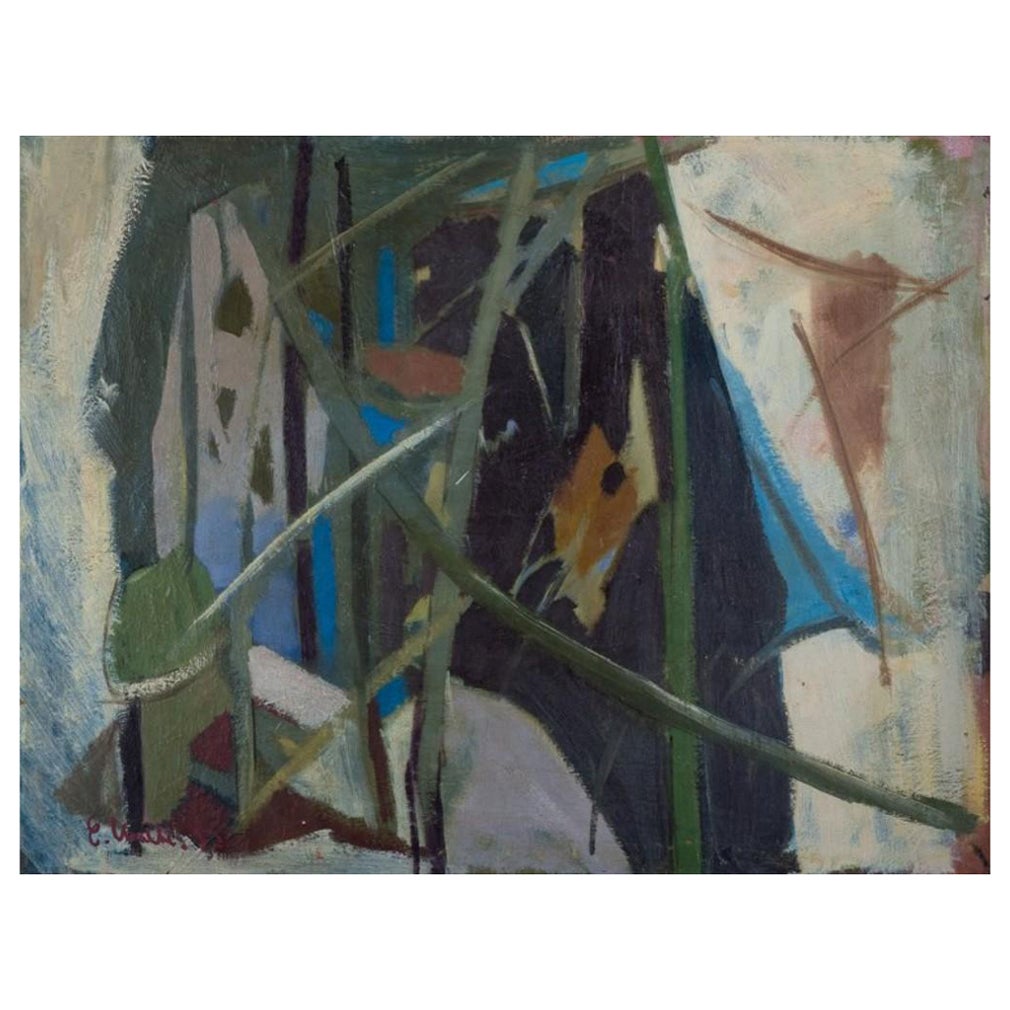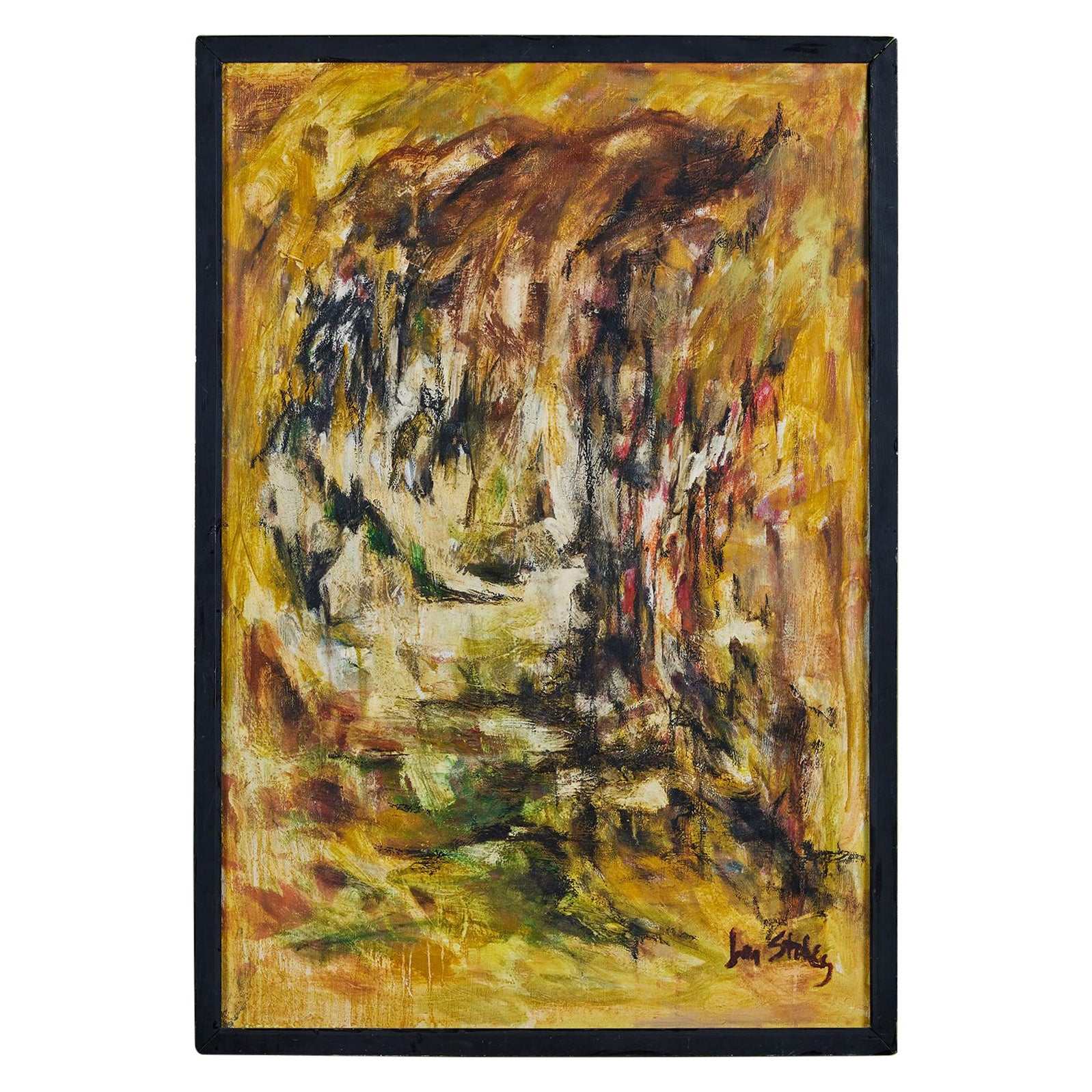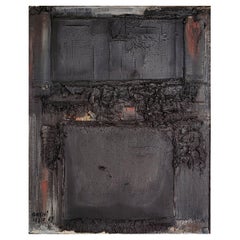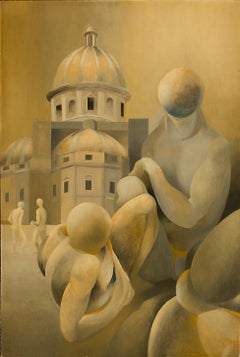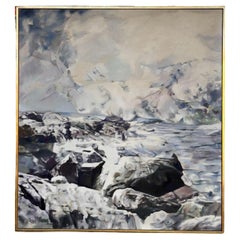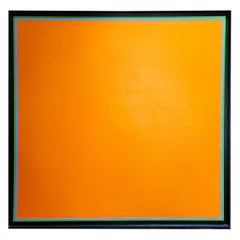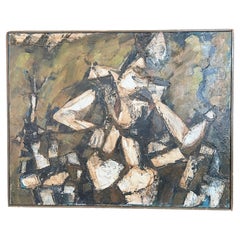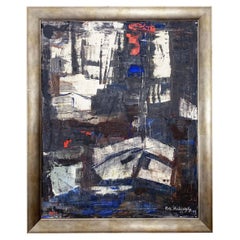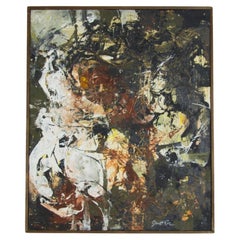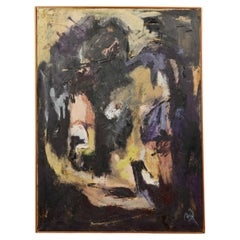Items Similar to John David Rigsby Abstract Mixed Media on Canvas, American 1960
Want more images or videos?
Request additional images or videos from the seller
1 of 7
John David Rigsby Abstract Mixed Media on Canvas, American 1960
$2,200
£1,706.23
€1,939.96
CA$3,138.96
A$3,425.90
CHF 1,799.37
MX$41,609.15
NOK 22,578.68
SEK 21,189.46
DKK 14,486.59
About the Item
A handsome and sophisticated mixed media on canvas by American artist John Rigsby. Found in a original state of preservation. His works are few and far between.
The following biography was submitted by John David Rigsby, Jr., son of the artist. The author is Lisa Rigsby Peterson, daughter of the artist, and owner of the copyright of the biography.
John David Rigsby was born on October 10, 1934, the seventh child of an Alabama Depression-era sharecropper's son. He and his family moved frequently, from one one-room structure to another, often with no running water, no plumbing, no heat but the stove. His father was killed in a car accident when Rigsby was just 9 years old. Life for the remaining eight family members proved tumultuous and difficult -- food wasn't plentiful, nor money. The family moved from place to place, following work -- Rigsby attended 30 different schools before graduating from high school. Despite living in poverty, Rigsby demonstrated academic and artistic aptitude at a young age. Two oil paintings on covers ripped off of old books that he painted when he was eight years old show the promise of an imaginative and gifted eye.
Rigsby was drafted by the U.S. Army in 1953. As he later wrote, "When basic training at Fort Jackson, South Carolina, was over, I was told to go out and find a job. Jasper Johns was painting visual aids for the 28th Regimental Headquarters. He suggested the Band Training Unit." Rigsby played the clarinet in that unit, and after 2 years of service, he enrolled at the University of Alabama on the G.I. Bill to study art. After just two years, he left school and followed his mentor (and one of the greatest and longest-lasting influences on his art), Japanese artist and U of A art instructor Tatsu Heima, to New York City. Heima introduced him to Isamu Noguchi and suggested that Rigsby work as Noguchi's assistant. Instead, Rigsby chose a job as a guard at the Metropolitan Museum of Art, since "the notion of seeing all of that art appealed more to me than the boring task of studio assistant." The opportunity was a rich one for Rigsby. He had a chance to study the masters, and cited Rembrandt with his simplicity and elegance as another of the most important influences on his work.
In the years between 1957 and 1963, when Rigsby eventually earned his BFA in sculpture, the artist traveled back and forth between New York and Tuscaloosa, alternating study with forays into the fertile New York art scene. Rigsby exhibited some of his early sculpture work in 1958 at a small New York gallery, which was also exhibiting the work of Willem and Elaine de Kooning and Theodore Stamos. Shortly thereafter, searching for an educational venue closer to New York City, Rigsby visited New Haven, Connecticut, and spent an afternoon speaking with Josef Albers at Yale. Albers agreed to accept Rigsby into the Yale program on the condition that he take freshman drawing all over again. A brilliant opportunity, but, in Rigsby's words, "When it was time to register, I was hitchhiking back to Alabama, looking for food and shelter."
Rigsby had his first one-man show at the University of Alabama in 1959. A visiting critic from New York, J.F. Goosen, reviewed the show and wrote "here is a talent which produces art because that is the thing for a gifted person to do. In his effortless ease of conception and execution, he has already achieved a goal that eludes many artists for a lifetime." Finally, in 1963, Rigsby received his degree in sculpture, dissolved a short-lived marriage, visited his family, packed up his car and headed permanently for New York. That year, his work was included in a group show at the Delgado Museum in New Orleans - which led to a one-man exhibit at the Delgado in 1964. During 1964, Rigsby took drawing classes at Columbia University, and worked at the General Post Office at night. He met his future wife, Linda Palmieri, and married. In 1965, his daughter Lisa was born, followed in 1966 by the birth of his son, John David Jr.
In 1966, Rigsby had a successful one-man show at the Pietrantonio Gallery in New York. Shortly thereafter, he and the family moved to Tunis, Tunisia at the suggestion of a colleague, who urged him to "come paint by the light of Klee." Rigsby worked for the United States Information Agency as a teacher, and he spent the next year and a half painting over ninety paintings inspired by the smells, light, and Phoenician and Roman art surrounding him. He also executed a number of character and landscape drawings, capturing the Tunisian way of life. During his time in Tunisia, Rigsby's work was shown there in two major exhibits.
Upon the family's return to the U.S. in 1968, Rigsby once again exhibited at the Pietrantonio Gallery. Later that year, Rigsby enrolled in Southern Connecticut State College's Urban Studies program, earning a master's degree in 1970. During his time at SCSU, Rigsby worked as the city of Bridgeport's Curator of Exhibits, driving a mobile art gallery from schools to neighborhood fairs and housing projects. After completing his degree, Rigsby had an exhibit at the Telfair Museum in Savannah, Georgia. This exhibit caught the attention of a member of the search committee looking to hire an artist for a newly-developed program in neighboring South Carolina.
In 1970, Rigsby was selected as the first Artist-in-Residence in the state of South Carolina for the National Endowment for the Arts Artists in Schools program. His work with the newly-integrated students at Beaufort (SC) High School over the term of his residency precluded substantial work on his own art. He did, however, set up a studio in downtown Beaufort, and was able to create a modest number of paintings, which were included in exhibits at the Columbia Museum in South Carolina in 1971 and Yale University in 1973.
At the end of his residency in 1974, Rigsby was named the National Visual Arts Coordinator of the Artists in Schools program for the NEA, a post he held for two years. In this position, Rigsby traveled the country, reviewing grant applications, meeting with state leaders in government, education and the arts to promote program concepts and explore local opportunities. The message he repeated over and over again echoed that of one of the other major influences on Rigsby as an artist - Ruth Asawa Lanier, whose words taught him that all of the work that the artist does is the artist's work, not simply the paintings he creates. In his capacity as National Coordinator, as well as many times in the future, Rigsby stressed that artists function in the same way as any other person in society, and deserved the same respect and place for their work as did all other professions. After two years traveling the country, Rigsby was ready for a change, saying "for the first time in my adult life, there was not a body of paintings to show for the years put into my work."
In 1976, a summer retreat to the mountain community of Central City, Colorado, led to a permanent relocation. Eventually settling in the small town of Evergreen, Rigsby followed his own advice about artists becoming actively involved in their communities, and he established the Evergreen Visual Arts Center. The Center provided working space for artists, classes for adults and children, and, most importantly, a place for Rigsby to create his own work. Buoyed by the opportunity to concentrate once again on his art, and inspired by his new surroundings, Rigsby entered an extremely prolific period in his career. In 1977, he organized a traveling exhibition of his paintings, which showed at the Kimball Arts Center in Utah, the Kennedy Center in Washington, D.C., and the Arvada Center in Colorado.
1978 brought more exhibits, notably in Aspen and Denver, as Rigsby's work continued. He took an extended trip to visit his mentor, Tatsu Heima, in Japan, where he climbed Mt. Fuji, followed by travels to Tehran, Delhi, and several European countries. He chronicled his impressions from his travels in a small collection of paintings upon his return to the U.S. - the beginning of a practice which would continue through the rest of his life. In 1979, Rigsby's marriage failed, and at the same time he lost the lease to his Evergreen studio to redevelopment plans. In response to the personal chaos around him, Rigsby began a series of what he called "hard-nosed process paintings," the watercolor paintings of dots which marked his work from this period. The paintings gained him an NEA Individual Artist grant in 1980, as well as a Yaddo fellowship in 1981. The polka dot paintings were followed by a series of cupcake-like images, again examining space and color.
During the early 1980s, Rigsby lived in a suite of old dentists' offices in a rundown part of Denver, with a studio in an area that reminded him of the Bowery in New York. In 1984, Rigsby founded the Progreso Gallery in the building where he lived, using the space both to show his own work and also to mount shows of the work of many Colorado artists. The gallery also served as a focal point for Denver's local arts community, hosting weekly discussion groups and classes. In 1984, Rigsby traveled to the Baja Peninsula and then in 1985 to Yugoslavia. After each sojourn, Rigsby returned to create vibrant and explosive paintings based on his experiences, showing them at his Progreso gallery and another alternative gallery in Denver, the Edge Gallery. The economic recession of the mid-eighties hit the art market and Rigsby hard, however, and although he continued to create new works of art, major exhibitions were difficult to come by.
In 1987, Rigsby decided to leave Denver and spent six months in Barcelona, Spain. It was an electrifying trip for him. Rigsby wrote of that time:
"The streets alone are a visual feast, and the additions of museums from Saarinen, Picasso and Miro to 12th century icons produced artistic indigestion. My paintings are always about the way things look and feel. Barcelona was a time machine extending those sensory and emotional concerns back to the Middle Ages. I felt the need to reduce my work to essential elements of color, scale, drawing and format. The [resulting] color studies speak eloquently for themselves, and in doing so, redefine all of the work I've done in the past 35 years of painting."
Rigsby completed over a hundred paintings while in Barcelona - color studies, street portraits of the characters he encountered on a daily basis, and a number of dark landscape paintings. He found time to run with the bulls in Pamplona, and began writing stories about his adventures that were later published.
Upon his return to Denver in 1988, Rigsby continued to explore the alter egos of the color studies - he concentrated on a series of dark paintings, all prominently featuring back. He commented about these black paintings that he " decided it was time to explore the perception of the eye and physical space as defined by low -light conditions…I find these paintings elegant, joyous and light-filled, with no feeling of heaviness at all." In mid-1988, Rigsby moved permanently to Houston, Texas, where he would spend the last five years of his life.
Once in Houston, Rigsby made a discovery that would serve as the inspiration and material for some of the last works of his career. In 1989, he discovered a salvage yard filled with scrap rubber, and he began working on black rubber sculptures, as well as paintings with rubber elements incorporated. He made strong connections in the Houston alternative arts scene, and became a regular contributor and art critic for a local weekly newspaper, The Public News. From 1989 through 1992, he exhibited his sculptures and paintings at Houston's Brent Gallery, Fountainhead Gallery, and Blaffer Gallery. He also produced an installation of his rubber sculptures on the roof of the Diverse Works Gallery in Houston. 1992 also marked Rigsby's return to Denver when he exhibited his sculptures at the Payton-Rule Gallery in Denver, leading to an Absolut Rigsby commission by Carillon Importers.
The 1990s were a tremendous struggle for Rigsby, with financial crises compounded by physical trauma (he accidentally sawed off the top joint of the index finger of his left hand while working in his studio). Although his work was being shown, it wasn't selling, and the tremendous financial pressure he felt weighed heavily upon him. He spent an increasing proportion of his time going to flea markets and garage sales, rehabilitating and repairing the things he bought there, and then re-selling them simply to raise enough money to keep a roof over his head. He had little time to paint or sculpt, the things in life that had always, no matter what the circumstances, brought him joy.
Rigsby's final works were a series of intricate paintings and drawings on used books that he purchased at the flea market. Most of these drawings, which he referred to as sculptural form drawings, were executed on page after page of science texts, music books, and a Korean bible and fill hundreds of pages. Additionally, Rigsby created an exquisite book he titled 28 de los Angeles, in which his twenty-eight simple and elegant drawings of angels resonated with the influence of Rembrandt he had so admired in his early days. In a sense, Rigsby's final works, art created on used books which were the only materials he could afford, brought his work and life full circle from his childhood days. Rigsby's life, though begun and ended in adversity, was nonetheless illuminated and enriched by the irresistible impulse he had to create art and beauty.
John David Rigsby was killed in a one-car accident in Colorado in August, 1993.
Biography from the Archives of askART
Following is a review by Michael Paglia of the artist's July 2004 retrospective at the Denver Museum of Contemporary Art. It was submitted by John Rigsby, Jr., son of the artist.
There's a magnificent retrospective at Denver's Museum of Contemporary Art devoted to the work of the late John David Rigsby, who was a major powerhouse in Colorado's art scene. "Dots, Blobs and Angels" surveys more than forty years' worth of the remarkable artist's paintings and sculptures.
The year 1993 was strange, and by that I mean terrible. Many of the city's galleries closed because of bad economic times, and then the artists started dying. In a matter of a few months, Denver lost three significant artists: Rigsby, experimental photographer Wes Kennedy and figural abstract painter Edward Marecak. Interestingly, all had been the subjects of solos within the previous two years, so they were fresh in everyone's minds.
I bring up Kennedy and Marecak in relation to Rigsby because the fate of their works debunks the widely held myth that once an artist dies, interest in his or her art increases. In truth, most artists, even those with distinguished careers and credible oeuvres, are gradually forgotten after they pass away.
Kennedy is a good example: Other than a piece or two in a group show, when's the last time you've seen one of his works? Marecak has fared better because he was part of the mid-century modern scene, and there's increasing interest in the artists of that period. Finally, there's Rigsby, who, like Kennedy, has been slowly forgotten. Dots, Blobs and Angels aims to rectify that -- and to a great extent, it does.
Cydney Payton, the MCA's able director, put together the show, selecting the pieces and, as usual, supervising the installation. On both counts, she's done a bang-up job. Her selections represent what she sees as the pivotal pieces of Rigsby's art, and by intelligently arranging them in chronological order (though there are some exceptions), Payton walks the viewer through Rigsby's subtle shifts of aesthetic theory.
- Dimensions:Height: 32.5 in (82.55 cm)Width: 24.5 in (62.23 cm)Depth: 1.5 in (3.81 cm)
- Style:Mid-Century Modern (Of the Period)
- Materials and Techniques:
- Place of Origin:
- Period:
- Date of Manufacture:1960
- Condition:Wear consistent with age and use.
- Seller Location:Hudson, NY
- Reference Number:1stDibs: LU8210238876142
About the Seller
5.0
Vetted Professional Seller
Every seller passes strict standards for authenticity and reliability
Established in 1991
1stDibs seller since 2023
17 sales on 1stDibs
Typical response time: <1 hour
- ShippingRetrieving quote...Shipping from: Great Barrington, MA
- Return Policy
Authenticity Guarantee
In the unlikely event there’s an issue with an item’s authenticity, contact us within 1 year for a full refund. DetailsMoney-Back Guarantee
If your item is not as described, is damaged in transit, or does not arrive, contact us within 7 days for a full refund. Details24-Hour Cancellation
You have a 24-hour grace period in which to reconsider your purchase, with no questions asked.Vetted Professional Sellers
Our world-class sellers must adhere to strict standards for service and quality, maintaining the integrity of our listings.Price-Match Guarantee
If you find that a seller listed the same item for a lower price elsewhere, we’ll match it.Trusted Global Delivery
Our best-in-class carrier network provides specialized shipping options worldwide, including custom delivery.More From This Seller
View AllAvshalom Okashi Abstract Composition Oil on Canvas Dated 1961
By Avshalom Okashi
Located in Hudson, NY
Okashi was born in Israel and studied painting while working as a Shepard in Galilee.
His early work was figurative and his later work featured bold abstracts, which established hi...
Category
Mid-20th Century Israeli Mid-Century Modern Paintings
Materials
Canvas, Paint
Surrealist Painting By Charles Oscar American Circa 1956
By Charles Oscar
Located in Hudson, NY
A rare piece to be found. Due to his early demise the number of works available by this artist are limited. His work can be found in every major collection in the United States. He was a Guggenheim Fellow, Museum of Modern Art Curator and rising Futurist Artist who was murdered in his New York apartment in 1961 when he was only 38 years old.
Titled "Hypnerotomachia", the name means 'the act of falling in love in a dream'. This amazing and rare piece was created just one year after his success with exhibiting at the Venice Biennale of 1956. Semi-abstract composition and very dream like. This painting retains the original carved and gilded Hydenryk frame and has been professionally cleaned and conserved.
His work can be found in every major collection in the United States. Charles Oscar...
Category
Vintage 1950s American Mid-Century Modern Paintings
Materials
Gold Leaf
Balcomb Greene Wind Ocean Sun 1963
By Balcomb Greene
Located in Hudson, NY
Wind, Ocean, Sun by Balcomb Greene painted in 1963. Signed on the front titled and dated on the reverse.
Paintings of the Montauk coast by Balcomb Greene are few and far between. Thi...
Category
Vintage 1960s American Mid-Century Modern Paintings
Materials
Canvas, Paint
Price Upon Request
Naohiko Inukai Oil On Canvas 1966
Located in Hudson, NY
A fantastic original oil on canvas by Naohiko Inukai. This is number forty in a series of colored scapes he created in the mid 1960's and is in excellent condition. This work is signed and dated on the reverse
It's color changes subtly with the lighting, when properly lit it casts a beautiful warm orange tone throughout the room.
Born in 1937 in Kurashiki-city Okayama,Japan. He came to the US around 1960 and returned to Japan around 1982 were he still resides.
Education:Cooper Union School of Art and Architecture New York...
Category
Vintage 1960s American Minimalist Paintings
Materials
Canvas, Paint
Balcomb Greene "The Cliffs", 1978
By Balcomb Greene
Located in Hudson, NY
The Cliffs by Balcomb Greene painted in 1978. Signed on the front titled and dated on the reverse.
Paintings of the Montauk coast by Balcomb Greene are few and far between. This painting likely created at his Studio in Montauk New York. Painting is in excellent original condition and retains the original gallery frame.
provenance: Estate of Gertrude B. Pascal / Gifted from the previous in 1987, The Frances Lehman Loeb Art Center, Vassar College, Poughkeepsie, NY / Christie's, New York 2012 / Private Collection, New Jersey
Public collections:
Baltimore Museum of Art, Baltimore, MD
Brooklyn Museum, Brooklyn, NY
Cleveland Museum of Art, Cleveland, OH
The Art Institute of Chicago, Chicago, IL
Corcoran Gallery of Art, Washington, D.C.
Guild Hall, East Hampton, NY
Wadsworth Atheneum, Hartford, CT
Museum of Fine Arts, Houston, TX
Indianapolis Museum of Art, Indianapolis, IN
Metropolitan Museum of Art, New York, NY
Museum of Modern Art, New York, NY
National Museum of American Art, Washington, D.C.
Joslyn Art Museum, Omaha, NE
Pennsylvania Academy of the Fine Arts, Philadelphia, PA
Norton Simon Museum, Pasadena, CA
Portland Museum of Art, Portland, OR
Neuberger Museum, Purchase, NY
Solomon R. Guggenheim Museum, New York, NY
Parrish Museum, Southampton, NY
Whitney Museum of American Art, New York, NY
Walker Art Center, Minneapolis, MN
Butler Institute of American Art, Youngstown, OH
Boca Museum of Art, Boca Raton, FL
Over a lifespan of 86 years, Balcomb Greene followed his muse wherever it led, unfettered by what had come before, unafraid of where the future might lead. Despite a series of different pathways explored, his purpose remained ever constant: to express truth as he found it and communicate it to a broader audience. In the 1930s, Greene was a young artist committed to abstraction as his expressive language. Greene’s paintings and collages of the 1930s reflect the influence of Pablo Picasso and Piet Mondrian and put him in the company of fellow Americans, including Ibram Lassaw, Josef Albers, Ilya Boltowsky and George L. K. Morris, all among the founding members, in 1936, of American Abstract Artists.
John Wesley Greene, his christened name which he never legally changed, was born in 1904 in Millville, New York, the third child and only son of Methodist minister The Reverend Bertram Stillman Greene (1864–1929) and Florence Stover Greene (1876–1911). His family on both sides were Revolutionary-era colonists, originally living in Connecticut and Vermont before joining the Yankee migration to the western frontier of New York State. In 1922, John Wesley Greene enrolled at Syracuse University aided by a scholarship for the sons of Methodist ministers and intending to fulfill the promise of his name and follow his father into the ministry. As with so many before and after him, the liberal education he absorbed at Syracuse broadened his horizons and reshaped his life plan. Studying philosophy, psychology, and literature, along the way he separated himself from organized religion. During his senior year, on a visit to The Metropolitan Museum of Art in New York City, Greene was introduced to Gertrude Glass (1904–1956), an art student and the Brooklyn-born daughter of Latvian Jewish immigrants.
Following Greene’s graduation, the two married in 1926 and went to Europe. They stopped briefly in Paris but spent most of their time in Vienna where Greene had a fellowship to study psychology. When they returned to New York in 1927, Greene enrolled in a master’s program in ‘English literature at Columbia University. When his thesis advisor rejected his essay topic on the “fallen woman” in seventeenth-century literature as inappropriate, he left without a degree. From 1928 until 1931, Greene taught English at Dartmouth College in Hanover, New Hampshire. At some point, he stopped using his given name, John, and began to call himself, more distinctively, Balcomb, the family name of his paternal grandmother.
While Greene wrote three novels (all unpublished) during his teaching years at Dartmouth, his wife was a working artist, and he eventually developed an interest of his own in painting. In 1931, Greene gave up his teaching position and he and Gertrude went to Paris, determined to immerse themselves in the modern art ferment they had briefly experienced in their earlier visit. For young Americans with no prescribed agenda, a receptiveness to innovation, and wide-open eyes and minds. Paris, in 1931, offered a rich stew of approaches to modern art. The city absorbed and transmuted an international mélange of styles—cubism, orphism, futurism, dadaism, constructivism, neoplasticism, suprematism, de Stijl, Bauhaus—France encountering Holland, Germany, Italy, and Russia with Pablo Picasso from Spain, Constantin Brancusi from Romania, and Jacques Lipchitz from Lithuania. As a sculptor, Gertrude Greene...
Category
Vintage 1970s American Mid-Century Modern Paintings
Materials
Canvas, Paint
Price Upon Request
Nude Oil on Canvas By Jacob Glushakow
Located in Hudson, NY
Jacob Glushakow (1914 – October 12, 2000[2]) was an American painter known for his keen observations of life in the city of Baltimore, Maryland, United States.
He graduated from the ...
Category
Mid-20th Century American Mid-Century Modern Paintings
Materials
Canvas, Paint
You May Also Like
Midcentury Abstract Oil Painting
Located in Chicago, IL
Midcentury abstract oil painting framed in simple wood frame.
Category
Vintage 1960s American Mid-Century Modern Paintings
Materials
Canvas, Wood, Paint
Original Abstract Oil Painting on Canvas by Rita Hvilivitzky, 1962
Located in Fort Lauderdale, FL
Original vintage abstract oil painting on canvas by Rita Hvilivitzky, 1962.
Category
Mid-20th Century American Mid-Century Modern Paintings
Materials
Canvas, Paint
Vintage Abstract Mixed Media Oil Painting by Janet Rae
Located in Fort Lauderdale, FL
A vintage abstract mixed media painting on canvas board done in oil, straw and sand by Janet Rae. Framed in a rustic wooden frame.
Category
Mid-20th Century American Mid-Century Modern Paintings
Materials
Straw, Paint
Mid-Century Modern Abstract Painting
Located in Ventura, CA
Abstract Mid-Century Modern Painting
This Light and Dark Abstract Mid-Century artwork is a captivating abstract painting that measures 36 inches in width and 48 inches in height....
Category
Vintage 1950s Mid-Century Modern Paintings
Materials
Paint, Acrylic
Swedish artist. Oil on canvas. Abstract composition. 1955
Located in København, Copenhagen
Swedish artist, oil on canvas. Abstract composition. Colouristic palette.
In excellent condition with minimal wear.
Indistinctly signed and dated '55.
Visible dimensions: 67.5 cm x 5...
Category
Vintage 1950s Swedish Modern Paintings
Materials
Canvas
Jon Staley Abstract Acrylic Painting
Located in Los Angeles, CA
Framed acrylic abstract painting on canvas by artist, Jon Staley featuring a range of earth tones. Signed by the artist.
Dimensions
25.75" width x .5" depth x 37.5" height.
Condit...
Category
Mid-20th Century American Mid-Century Modern Paintings
Materials
Canvas, Paint, Acrylic
